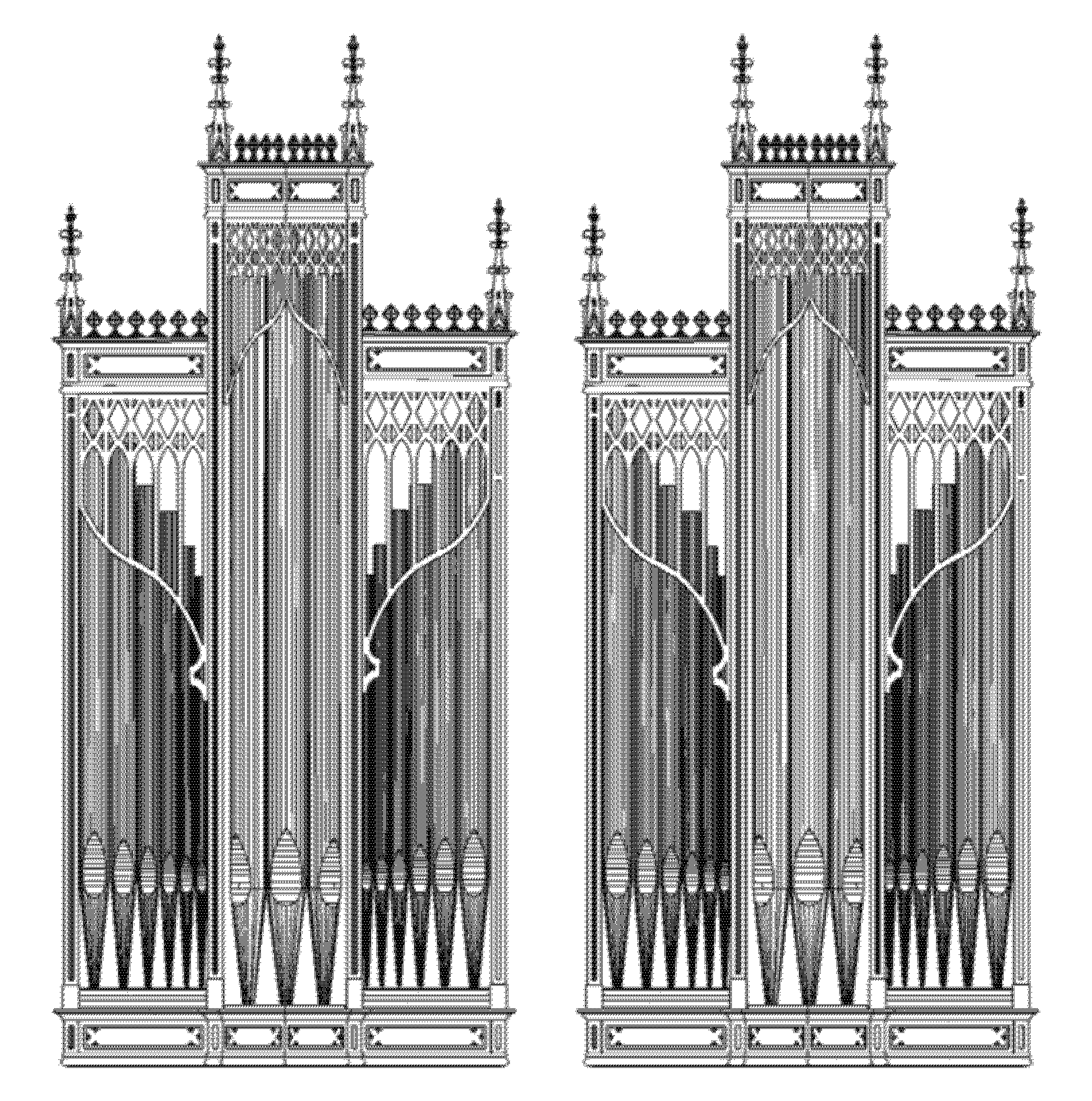Casavant Freres Organ Opus 3956
3 manuals, 42 ranks over Great, Swell, Solo and Pedal. Delivery in mid 2024 with completion in November, 2024.
Background
The pipe organ in the Historic Church has served Christ Church for over 110 years, in many iterations. It began as a concert hall organ, built by the Roosevelt Organ Company and installed in New York’s Chickering Hall. Following the closure of the hall in 1902, the organ was purchased by Thiel College and placed in storage. It was never installed, and following the possibility of its demise, it was purchased by CCG and installed by the Moller Organ Company in 1911.
Significant changes were made to the organ upon its original installation, in 1940 when it was rebuilt, and since the 1970’s, when many of the pipes were discarded in favor of newer pipes. Today, the organ bears little resemblance to its original 19th century form. While the pipes of an organ can last for many years, the mechanical components do not. This is, in part, due to the significant amounts of leather used in an organ and the electronic mechanisms (most of which date from 1940).
First Steps
Shortly after Dr. Robertson began his tenure as Director of Music, in 2020, he ordered a thorough review of the condition of the organ, noting many tonal and mechanical shortcomings when first encountering the instrument. In January of 2021, the Muller Organ Co. of Croton, OH was hired to inspect and review the organ. Their report listed many failures of the instrument, and recommended a full rebuilding or a new instrument. One of the main issues is the thousands of leather pouches that play each individual pipe are significantly decayed, after nearly 50 years since they were last replaced. Leather of the day has a lifespan of 30-40 years, so it has far outlived its intended lifespan.
Temporary Fixes
In order to marginally improve the organ’s deficiencies for resumption of regular playing (following live-streaming from the Chapel only during Covid-tide) the Buzard Organ Co. was hired to restore the badly deteriorated 8’ Clarinet stop, add new Swell shade motors, improve the combination action and fix a few voicing issues. The Walker Technical company was hired to add a few digital stops, including some low bass stops and an 8’ Tuba. The cost of this work was approximately $75,000 funded by the Procter Fund. These fixes were meant to improve the organ on a short-term basis and allow some time for a long-term solution to be decided on. The organ was anticipated to have approximately 3-5 years of good playing life left before it would be in disrepair, or even unplayable.
An Organ Committee Was Formed
After the temporary fixes were completed in late 2021, with the Rector’s approval, Dr. Robertson began exploring the possibility of a long-term solution for the organ. He contacted several reputable organ companies and began having dialogues about what the best next step would be for CCG. Five organ companies came to visit CCG and did their own thorough inspections of the instrument and its mechanisms. They each provided a detailed proposal for a new organ, understanding that simply rebuilding the instrument as-is would not be the best use of the church’s resources. In the Spring of 2022, the Vestry approved the formation of an organ committee, made up of Tricia Ettinger, Bob Hamilton, Mark McGrew, Priscilla Neill, Sharon Woodrow and Dr. Robertson. The committee began meeting weekly, first discussing the condition of the current instrument and seeing the inside up close. They determined a new organ was in the best interests of the church and its music ministry. That recommendation was made to the Vestry, who accepted it and approved the acquisition of a new pipe organ. At this time, the committee began working in earnest, carefully reviewing the proposals provided by the organ companies.
The Committee’s Work Moves Forward
The members of the organ committee discussed the intricacies of the proposals, guided by Dr. Robertson (to explain all the technical jargon!). Following Dr. Robertson’s recommendation, the five organ companies were narrowed to three finalist companies. The finalists were notified and asked to travel back to CCG to make a presentation to the organ committee. These happened in November and December of 2022. In early December of 2022, Dr. Robertson visited an organ built by each of the finalist companies, spending time playing them, inspecting the internal parts, and interviewing each church’s organist—who had in-depth information about their instruments and their time working with each organ company.
Coming to a Conclusion
Following the “organ auditions”, Dr. Robertson made a presentation to the committee of his findings and experience with each instrument. He confidently recommended CCG choose the Casavant Freres Organ Company of St. Hyacinthe, Quebec, to build CCG’s new organ. This recommendation was overwhelmingly and unanimously approved by the organ committee. On Dec. 23rd, CCG signed a contract with Casavant, for their Opus #3956, to be completed in late 2024.
The New Organ
While this is technically a “new” organ, it will incorporate many pipes from the current instrument, including some from the very first 1867 organ. The pipes which are chosen to be kept are those which meet two criteria: 1. They must be in good enough condition to be reused or restored, and 2. They must fit in with the tonal concept of the organ. Many of the pipes that have been added since the 1970’s are far too loud, bright, and/or aggressive to be reused. Casavant will use the best of the historic pipes in our new organ.
The remainder of the pipes will be built in-house by Casavant. They are one of the few North American organ companies who build all of their own pipes. The new organ will have over 2,600 pipes made of wood and metal, each one painstakingly handmade.
The old organ façade, which partially collapsed in 2022, will be replaced by a modern, elegant wood case of two towers that houses some of the largest metal pedal pipes (renderings below).
Organ Specification
About Casavant Freres
The Casavant Freres Organ Company was formed in 1879 and has been in business ever since. Their first organ (Opus 1) was built in 1880 and is still playing weekly church services today! They employ 40 full-time craftspeople that build almost every part of each organ in-house. Our organ will be Opus 3956, nearly the 4,000th pipe organ they have built in their 140 year history. This company is known for excellence and quality worldwide and has many notable installations, which include some of the largest concert halls (The Kennedy Center in Washington, DC for example) and cathedrals, as well as some of the smallest parish churches. Despite size, each one of their instruments receives the same care in design and construction.




